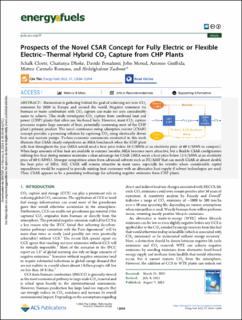| dc.contributor.author | Cloete, Schalk Willem Petrus | |
| dc.contributor.author | Dhoke, Chaitanya | |
| dc.contributor.author | Bonalumi, Davide | |
| dc.contributor.author | Morud, John | |
| dc.contributor.author | Giuffrida, Antonio | |
| dc.contributor.author | Romano, Matteo Carmelo | |
| dc.contributor.author | Zaabout, Abdelghafour | |
| dc.date.accessioned | 2024-04-10T13:25:47Z | |
| dc.date.available | 2024-04-10T13:25:47Z | |
| dc.date.created | 2023-09-06T08:48:23Z | |
| dc.date.issued | 2023 | |
| dc.identifier.citation | Energy & Fuels. 2023, 37 (16), 12030-12044. | en_US |
| dc.identifier.issn | 0887-0624 | |
| dc.identifier.uri | https://hdl.handle.net/11250/3125855 | |
| dc.description.abstract | Momentum is gathering behind the goal of achieving net-zero CO2 emissions by 2050 in Europe and around the world. Negative emissions via biomass or waste combustion with CO2 capture can make net zero considerably easier to achieve. This study investigates CO2 capture from combined heat and power (CHP) plants that often use bio-based fuels. However, most CO2 capture processes require large amounts of heat, potentially consuming most of the CHP plant’s primary product. The novel continuous swing adsorption reactor (CSAR) concept provides a promising solution by capturing CO2 using electrically driven heat and vacuum pumps. Techno-economic assessments conducted in this work illustrate that CSAR clearly outperforms an MEA benchmark when the CHP plant sells heat throughout the year (MEA would need a heat price below 10 €/MWh at an electricity price of 60 €/MWh to compete). When large amounts of free heat are available in summer months, MEA becomes more attractive, but a flexible CSAR configuration utilizing free heat during summer maintains a clear advantage for CSAR (MEA needs a heat price below 15 €/MWh at an electricity price of 60 €/MWh). Stronger competition arises from advanced solvents such as PZ/AMP that can match CSAR at almost double the heat price of MEA. Still, CSAR will remain attractive in most cases, especially for retrofits where considerable capital expenditures would be required to provide existing heat customers with an alternative heat supply if solvent technologies are used. Thus, CSAR appears to be a promising technology for achieving negative emissions from CHP plants. | en_US |
| dc.language.iso | eng | en_US |
| dc.publisher | American Chemical Society | en_US |
| dc.rights | Navngivelse 4.0 Internasjonal | * |
| dc.rights.uri | http://creativecommons.org/licenses/by/4.0/deed.no | * |
| dc.title | Prospects of the Novel CSAR Concept for Fully Electric or Flexible Electric–Thermal Hybrid CO2 Capture from CHP Plants | en_US |
| dc.title.alternative | Prospects of the Novel CSAR Concept for Fully Electric or Flexible Electric–Thermal Hybrid CO2 Capture from CHP Plants | en_US |
| dc.type | Peer reviewed | en_US |
| dc.type | Journal article | en_US |
| dc.description.version | publishedVersion | en_US |
| dc.rights.holder | © 2023 The Authors. Published by American Chemical Society. | en_US |
| dc.source.pagenumber | 12030-12044 | en_US |
| dc.source.volume | 37 | en_US |
| dc.source.journal | Energy & Fuels | en_US |
| dc.source.issue | 16 | en_US |
| dc.identifier.doi | 10.1021/acs.energyfuels.3c00885 | |
| dc.identifier.cristin | 2172780 | |
| cristin.ispublished | true | |
| cristin.fulltext | original | |
| cristin.qualitycode | 2 | |

